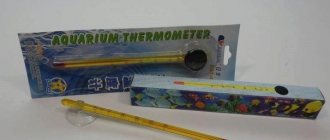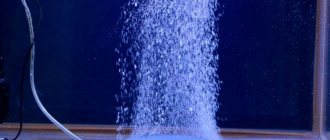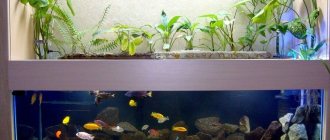What to do if there is a leak in the aquarium? How to properly seal cracks, replace glass, patch the bottom? Methods of strengthening walls with ties and stiffeners with a step-by-step description of the algorithm of actions.
When cracks appear on the tank glass or seams leak, many aquarists decide to replace it. If the volume of the vessel reaches 80-100 liters, it makes sense to carry out routine repairs and save on the purchase. How to seal an aquarium and eliminate end leaks will be helped by recommendations from home craftsmen.
How to seal seams with sealant
The most common problem is leaking. First you notice single drops on the cabinet, then puddles form from them. This happens when a leaking aquarium is many years old, and the dried sealant from old age begins to peel off and crumble. Sometimes the problem appears when removing algae with a metal scraper from the walls, touching the waterproofing seam. To find where the water is leaking from, carry out repairs:
- move the fish to another container along with plants and water from the container;
- remove the soil;
- Wash the walls thoroughly and dry with a paper towel;
- fill the container with water;
- Wrap the outside of the joints with corrugated paper or a thick napkin.
In a depressurized area, it immediately gets wet, which helps to accurately determine the location of the problem. If the aquarium leaks along the seam, break the blade in half and cut off the old glue with one part at the leak site. Degrease the working area with alcohol and apply silicone sealant to the dry surface. Before doing this, do not forget to cover the glass with masking tape. The adhesive present in the composition ensures strong bonding. After half an hour, the silicone polymerizes and reliably seals the holes.
Leave the tank for a day. During this time, the glue turns into a monolith, toxic substances dissolve in the air. Do a paper check. If it is dry, the container is ready for use. In an emergency, relocate the fish an hour after the putty has set. Silicone vapors do not pose a great danger. To be on the safe side, turn on the intensive air supply for 2-3 days. If air bubbles suddenly form on the seam, fill it pointwise with silicone using a syringe. If voids appear in the dried silicone, clean the joint and reapply the sticky layer.
Why do you need aquarium glue?
Beginners in fish breeding prefer to buy ready-made containers, while professional breeders often make aquariums with their own hands. This allows you to achieve a unique design, the required width and length, and provide for the placement of decorative elements and aquatic plants.
The glue will also be useful in case of breakage: cracks on the walls, bottom or lid, as well as in case of depressurization of joints. In any case, the glue must have certain characteristics. Simple water resistance and durability are not enough here.
What kind of sealant should it be?
Sealants are used to bond glass. Such products are produced in a wide range, but not every sample is suitable for repairing an aquarium. A few mandatory requirements:
- Elasticity. The walls of the aquarium will be constantly exposed to water. The glue must not only withstand lateral pressure, but also adapt to such conditions. Due to the excessive strength of the adhesive seam, cracks may appear in the glass.
- Reliability. The sealant will be exposed to water from the inside and air and light from the outside. It must also withstand the temperature difference between the water and the room.
- Safety. The glue must not be toxic. Otherwise, it will pose a danger to the inhabitants of the aquarium - fish and plants. Some sealants begin to release harmful substances when in contact with water, for example, construction asphalt sealant and other synthetic adhesives.
- The composition should not contain antibacterial substances. They negatively affect the fish. The inscription “antifungal” or “antimicrobial” is a reason to refuse the purchase.
- The dyes in adhesives not intended for aquarium use can be harmful to plants and creatures.
- Sealants are acidic and neutral. For a fish house it is permissible to use only neutral ones.
Preparation for the procedure
Any actions with the aquarium related to repairing its frame must be accompanied by steps that are aimed at preserving the lives of its inhabitants. Therefore, if the owner decides to do this, he will have to think about where to temporarily relocate them in order to ensure the most similar microflora. This way they can comfortably wait out the whole process and move back in without any losses.
Any vessel of at least approximately similar volume is suitable for a temporary home for aquarium fauna. Even a jar will be enough for two or three small fish. The most important thing in this process is the transfer of soil from the bottom and the plants that grew in it. They will be needed to produce oxygen, since the temporary container will be a refuge for the fish for several days. There is no need to replant the entire mass - only the amount that is evenly distributed along the bottom.
Before repairing the aquarium, you need to temporarily relocate its inhabitants into a suitable container.
Next, everything needs to be done according to this scenario:
- Remove remaining liquid and flora from the soil.
- Rinse the bottom and walls, dry naturally.
- If there is a backlight, remove it and turn off the power.
This will allow you to quickly repair the aquarium with your own hands so that the moving of animals is as painless as possible and keeps all life support systems in good working order. Then the subsequent assembly of an already repaired tank will not be difficult, since everything will be prepared for the reverse sequence of actions.
To establish the exact location of the leak , if this is exactly it and no traces of cracks or chips are visible on the glass, you can use paper. Corrugated cardboard is a good choice because it absorbs moisture and, when wet, changes color to a darker shade that is very easy to distinguish. By attaching its sheets to the walls, you can find out where the source of the puddle is very quickly.
Types of sealants
What to rely on when choosing glue? Look at the composition of the product:
- Acrylic sealants are susceptible to moisture and have a low level of adhesion, so they are not suitable.
- Bitumen, polyurethane and polysulfide compounds are used only in construction and are not suitable for assembling and repairing fish housing.
- Butyl sealant is a good option for aquariums, but it is not very durable.
- An acceptable option is epoxy glue, but before applying it you need to thoroughly clean the surfaces, and it also takes a long time to set and has a runny consistency, which complicates the work.
- Silicone adhesive sealant is elastic. This is a universal product that is used in everyday life for different purposes. Silicone adheres well to various surfaces and does not emit toxic substances. It is best to choose this type of sealant for an aquarium.
- You can try cold welding. This glue sets in minutes and has a chemically neutral composition.
Advantages of silicone sealant:
- Does not emit harmful substances either upon contact with water or into the air.
- No special protective equipment is required to work with it.
- Convenient to use.
- Long service life.
- It hardens quickly, on average in 20 minutes in air due to the moisture content in it. Polymerization is completed after a day.
- The sealant seams remain strong and do not crack, as they have sufficient elasticity. The glue seam can withstand a load of 200 kg.
On some packages there is a mark stating that the glue is intended specifically for glass and aquariums. If the composition contains silicone, such glue can be used. Also keep in mind that sealants vary in color: there are transparent, white and black.
Advice! If the store does not have a suitable sealant for an aquarium, take glue for plumbing or dishes, but only without antifungal additives.
Even if there is the slightest doubt about the quality or composition of the glue, then it is not worth the risk. Even a glued crack can lead to poisoning of underwater inhabitants.
Making the lid
To complete the design, it is important to provide an aquarium lid. The cover helps protect shellfish and fish that may jump out of the water, causing their death. The simplest lid option would be a thin plastic sheet. It needs to be placed on stiffening ribs.
If desired, the coating can be made of durable plastic or silicate glass. Lighting can be placed on the lid. For convenience, a handle is attached to the product. This helps to open and close the container. To avoid damage to the top of the glass, it is recommended to make a soft layer of sealant. Before making the lid, it is worth measuring the dimensions of the container. Thanks to this, it will look harmonious.
Product examples
Silicone for aquariums is what people call products for gluing fish containers together. The most commonly used compositions:
- Tytan is a special high-quality aquarium glue produced in Poland. It provides a long-lasting seal, but is quite expensive. This is an ideal option for gluing large aquariums.
- Soudal is a glue from Belgium, specifically for assembling and repairing aquariums. Suitable for containers of any size. It is considered the best option in terms of quality.
- Krass is another Polish sealant that is more affordable. It has acceptable quality and is mainly used for gluing small containers up to 50 liters.
- Okyanys Kimya is a Turkish product that provides reliable and durable glass bonding.
- “Moment sealant” is a special silicone sealant for aquariums from the famous “Moment” series from Henkel.
Crack in glass
Not all damage to an aquarium can be repaired with a sealant. So, for example, if a leak occurs due to a crack in the wall of a reservoir, then the only possible option is to replace the glass with a new one.
Otherwise, masking the problem with glue will only help for a while. Then the glass will burst.
Glue is a real assistant to every aquarist in the fight for the condition of his pond. But it is important to take a responsible and careful approach not only to the choice of the sealant itself, but also to the stages of its application. Then glue can really solve many problems.
How to glue and repair an aquarium
Assembly instructions:
- The working surface is covered with polyethylene.
- The glass is covered with masking tape to protect it from dirt (with a small indentation from the edge equal to the width of the glass).
- The parts to be glued are degreased: wiped with a cotton swab dipped in alcohol or acetone.
- The glue is applied in an even layer.
- The vertical sides are installed around the bottom. The front part is glued first, then the side and back walls.
How to fix a leaking aquarium:
- You need to carefully examine the location of the leak; perhaps it is simple condensation.
- Remove the fish and drain the water.
- The sealant is applied to the dry and clean glass surface.
- You can drop a little glue into the crack and push it inside. And so on both sides. The protruding part of the glue is leveled with a finger or a rubber spatula.
It is better to order aquarium glass from a workshop, where it will be cut evenly by machine. The material chosen is silicate, of the highest quality. There are two types of glass - window and polished. The first type is not suitable due to its non-uniform structure, but the polished material will stick together reliably. The optimal thickness is 0.8-1 cm. If the glass is thinner, the aquarium will most likely crack.
Glass replacement
The simplest aquarium in which you can quickly replace the wall and continue using it is a frame one. All the glass in it is inserted into special glued sealed grooves, which can be disassembled very well. To do this, just carefully scrape off the existing glue with a penknife or other flat object. Once the cracked wall is free of the substance holding it in place, it can be removed and set aside. You also need to be very careful to ensure that it does not crumble into small pieces or break on the floor.
After this, the grooves are cleaned of dried glue and degreased as thoroughly as possible. To do this, you can use either a regular solvent or something more serious like nail polish remover.
The simplest aquarium in which you can quickly replace the wall and continue using it is a frame one.
The next step will be installing new glass. It must be prepared in advance. Such walls are sold in special stores for aquarists and have a standard size and thickness. If you can’t find a replacement, you can arm yourself with a glass cutter, a grinder and a piece of glass of a suitable size. The only thing that needs to be taken into account is that all the edges will have to be thoroughly smoothed by grinding.
Another option is adhesive; it is much more complicated, primarily due to the fact that the layer of sealant or glue between the walls is much thicker. Here the sequence of actions will be as follows:
- First you need to try to separate both walls without using additional means, except for a knife, of course. You should use the blade carefully, since without a frame the glass is attached to another glass of the same type, and therefore there is a risk of damaging both surfaces.
- If this fails, you need to start gradually heating the sealant. More than 70 - 80 degrees is unlikely to be needed, so you can use a regular household hair dryer to dry your hair. In the silicone softened by hot air, you need to make an incision, which, even with subsequent cooling, will not allow the parts to stick back so tightly.
- After separation, the remaining glue is removed in any convenient way, but so that not a trace of it remains on the edges.
- New sealant is applied to the cleaned joints, including the new one, and then they are pressed against each other. For primary fixation, it takes less than 5 hours, but after that it is impossible to remove the frame that holds the entire structure in one position; it is better to wait a day or a little more.
To avoid leaks, testing is mandatory.
To avoid leaks, testing is mandatory. The water used for this is not suitable for fish and other living creatures, since toxic substances from the adhesive mixture can dissolve in it, so you should leave it for another day, make sure that there are no leaks with adhesive paper or a piece of cardboard.
Repairing an aquarium at home is not a difficult task if you approach it responsibly and purchase all the necessary spare parts. The main difficulties may be with re-launching it into operation. But here it is enough to rely on the instructions and correctly approach the distribution of existing sludge and algae.
Tips for working with glue
When working with aquarium glue, you need to follow several rules:
- Before applying glue, surfaces must be cleaned and degreased, otherwise the glue will not adhere.
- If you need to remove excess glue, use a rag soaked in a vinegar solution.
- The substance does not lay down in layers. Old sealant must be removed with a knife. Sometimes this takes a lot of effort, so it's easier to buy a new container instead of repairing the old one.
- Fish should always be removed during repairs, even if a crack has formed in the upper part of the aquarium.
- If you are working with glue for the first time, then it is better to choose transparent compounds, and also use a special gun for spot application.
- If the adhesive reaches the end of its shelf life, a decrease in the quality of the product is inevitable.
Pets deserve the best. You should not save money and buy cheap adhesive products that will harm the creatures and plants in the aquarium. A high-quality sealant will eliminate cracks for a long time and will not cause trouble.
Fixing the leak
The cause of the leak lies in the damage to the adhesive. Over time, the sealant connecting the glass at the junction loses its properties and becomes damaged. To fix the problem, you can repair the aquarium yourself. If the aquarium leaks, repairs must be made by first preparing the container for repair.
Preparation for repair
Temporarily move the fish and aquarium inhabitants to another container. If this is not done, the fish will become stressed due to the intervention. It is desirable that the vessel serving as a temporary habitat be spacious. Place aquarium plants there or place them in a separate jar.
Add water from an aquarium that is leaking to avoid sudden changes in parameters and not disturb the bacterial balance of the aquatic environment.
Wash the object being repaired inside and out with a sponge, and remove the soil. After this, dry the tank; paper napkins will help with this.
Leak test
After cleaning and completely drying the outer part, an external inspection is carried out. This is necessary to identify leaking areas. The side joints between the glasses most often require repair. To detect cracks, the tank is filled with clean water, and a paper napkin or corrugated paper is applied to the outer surface of the glass. The paper is held on each area for several minutes. The leak will be found even if the damage is not visually noticeable.
When repairing an aquarium at home, glass that has cracks running through its entire surface must be completely replaced. When water is poured into a glass vessel, internal pressure is created, and even if everything is stuck and nothing is leaking, the glass will burst sooner or later.
If the cracks are small, they can be sealed with aquarium sealant. Without draining the water, mark the areas to be repaired. After making sure all problem areas are marked, drain the water.
Sealing the aquarium
Do-it-yourself restoration is done by welding cracks or gluing surfaces with a special glue - silicone sealant. It contains silicon, which ensures durable bonding of surfaces. Glass is often glued with this glue when making frameless fish houses. You can buy sealant in construction stores, less often in pet stores. A mark on the packaging indicating the suitability of the glue for an aquarium is required. For convenient application, get a special gun; it will allow you to better glue the new parts of the rectangular container.
Removing old sealant
When the surfaces are dry, clean the soaked sealant from the seams being repaired. A knife or nail file can be used to clean large gaps; a blade is suitable for narrow openings. This stage will require skill and patience. When the glass is cleared of old glue, the surfaces are degreased with acetone or medical alcohol.
Don't ignore these steps. A common reason why an aquarium leaks even after repair is a lack of attention to preparatory work.
Subsequent stages of work
After finishing the preparation, you can seal the problem areas:
- If glass is being replaced, prepare replacement material in advance. The glass panel can also be made from plexiglass. All joints and edges are generously coated with glue, then new glass is installed in place of gluing and secured with rope. Wrap the tank vertically and horizontally. After an hour, the operation should be repeated.
- If a leak has formed at the junction of the walls, the sealant is applied along the seam and rolled inward using a knife or nail file. For a good result, do not skimp on glue.
- Use a damp sponge to spread the silicone over the seams.
- Wait for it to dry completely; this should take at least a day.
- When everything is ready, do not rush to put the fish into the container. First, the aquarium is tested for the quality of the bond. To do this, you need to fill it with water and watch for leaks. If a leak occurs, the aquarium will need to be repaired again.
- After the work is done well, the test liquid is poured out and the container is filled with old water along with fish and plants.










